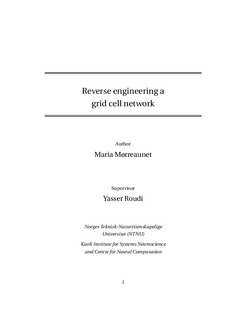| dc.contributor.advisor | Roudi, Yasser | nb_NO |
| dc.contributor.author | Mørreaunet, Maria | nb_NO |
| dc.date.accessioned | 2014-12-19T14:22:02Z | |
| dc.date.available | 2014-12-19T14:22:02Z | |
| dc.date.created | 2014-08-06 | nb_NO |
| dc.date.issued | 2013 | nb_NO |
| dc.identifier | 736368 | nb_NO |
| dc.identifier.uri | http://hdl.handle.net/11250/264266 | |
| dc.description.abstract | The neural circuitry comprising what is assumed to be the brain`s spatial navigation system has been investigated by scientists for decades. Research has revealed how the neural networks underlying this cognitive function might operate, and the grid cell network of the medial entorhinal cortex has been suggsted to function as a path integrator. How neural networks, such as those of grid cells, operates, is likely to depend on the connectivity within the network. Much is know about the physiological connectivity between the cells in the medial entorhinal cortex, but the question of how the grid cell network is functionally wired is still debated.
Here, we have taken a statistical approach to this quation. We have employed a statistical model- the kinetic Ising model- to reserve engineer the functional connectivity of a network cells recorded in vivo. Diffrent versions of the model were constructed to allow it to explain spatio-temporal variations in the firing of the cells. This was done by including components assumed to modulate the cells in the external fields of the kinetic Ising model. We have investigated how the differences in external field of the model affect the inferred functional connectivity between the cells, and how the inferred functional connectivity relates to what had been found experimentally.
Our main findings are that including pairwise correlations in the model increases the model quality for all models, and that the inferred connectivity of the network remains remarkably stable when altering the external field. In addition, we find indications of stronger functional connectivity within grid cell modules than between, and indications that the within-moduele functional connectivity decreases with phase distance. | nb_NO |
| dc.language | eng | nb_NO |
| dc.publisher | Norges teknisk-naturvitenskapelige universitet, Det medisinske fakultet, Institutt for nevromedisin | nb_NO |
| dc.title | Reverse engineering a grid cell network | nb_NO |
| dc.type | Master thesis | nb_NO |
| dc.source.pagenumber | 79 | nb_NO |
| dc.contributor.department | Norges teknisk-naturvitenskapelige universitet, Det medisinske fakultet, Institutt for nevromedisin | nb_NO |

